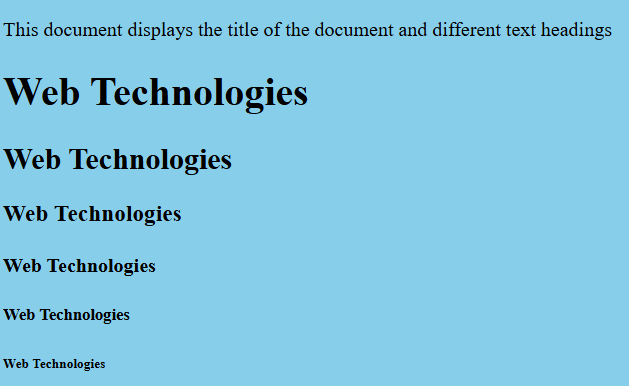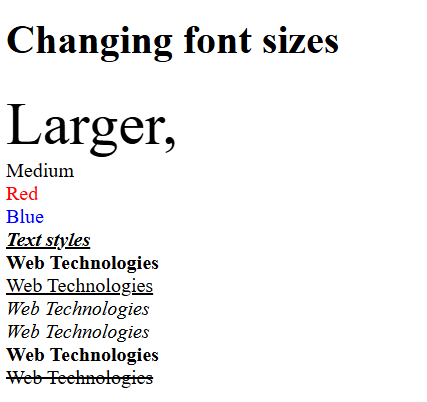Introduction to HTML: Your Gateway to Web Development for B.Tech Students!
Hello there, future Web Wizards! 👋 Are you ready to dive into the fascinating world of web development? As B.Tech students, understanding the bedrock of the internet – HTML – is not just an academic requirement, it’s a superpower in the making! Forget rote learning; we’re here to unravel HTML with a practical, exam-oriented, and undeniably desi flair! Let’s conquer the web, one tag at a time!
Unlocking the Web: A Deep Dive into HTML and its Essential Tags for B.Tech Superstars!
What in the World is HTML? Your First Step to Web Mastery!
Imagine you’re building a grand structure, say, a sprawling temple or a cutting-edge tech park. You wouldn’t just start pouring concrete, right? You’d first lay down a solid blueprint, outlining where every wall, every room, every intricate detail goes. In the digital universe, HTML (HyperText Markup Language) is precisely that blueprint for your webpages!
It’s NOT a Programming Language: Let’s get this straight from the get-go, folks! HTML isn’t for complex calculations or dynamic functionalities. It’s a markup language which provides a set of tags suitable for making up webpages.
The Foundation of the Web: Every single webpage you visit, from your favorite e-commerce site to your university’s portal, is built on HTML. It’s the skeleton, the backbone, the very aadhi shakti of web content!
Browser’s Best Friend: HTML is a scripting language for web pages and output of programs can be seen after using browser. It provides a set of tags suitable for making up webpages. When you open an HTML document in a browser, it reads these tags and renders the page accordingly.
More Than Just Text: Don’t let “Text” in its name fool you! HTML is a hyper text Language, because it supports font styled text, pictures, graphics and animations. It transforms plain text files into visually engaging web experiences. HTML documents are plain text files, created by using text editor like notepad.
Tag-Based System: At its core, HTML is a tag-based system. A tag is a special instruction for browser. A tag is made up of a left operator (<), a right operator (>), and a tag name between these two operators. Crucially, don’t give any space between the left operator and the tag name.
Opening and Closing Acts: In HTML, every tag can have a corresponding ending tag preceded by backslash Symbol. For example, <html> is the starting tag and </html> is its ending tag. This defines the scope of the content the tag affects. Optionally tag name contains one or more parameters. The browser won’t generate any error.
The Basic Blueprint: Structure of an HTML Document
Every well-organized construction needs a plan, and HTML documents are no different! All HTML documents follow some basic structure. They follow a basic structure that ensures your browser understands how to present your content. It has two blocks: Head block and Body block.
Example HTML Document Structure:
HTML
<!DOCTYPE html>
<html>
<head>
<title>My Awesome Webpage</title>
</head>
<body>
<h1>Welcome, B.Tech Students!</h1>
<p>This is where your amazing content goes.</p>
</body>
</html>
What to Expect: When you open this in a browser, you will see a page titled “My Awesome Webpage” in the browser tab. The main content area will display a large heading “Welcome, B.Tech Students!” followed by a paragraph.
Output (Simulated Browser View):
Plaintext
(Browser Tab/Title Bar: My Awesome Webpage)
Welcome, B.Tech Students!
This is where your amazing content goes.
Let’s break down this fundamental structure:
<html>...</html>: This is the basic tag of an HTML document. By using this tag the browser can identify whether it is an HTML document or not.<head>...</head>: The first part of HTML document, it contains control information used by the browser and title of the document.<title>...</title>: It specifies the title of the HTML document. This appears in the browser’s title bar or tab. For SEO, this is pure gold!- Metadata (like character set, viewport settings), links to external CSS files, and JavaScript code usually reside here.
<body>...</body>: It indicates the second part of HTML document and it contains all the remaining information about the webpage. Everything you want your users to see – text, images, videos, forms, tables – goes inside this tag. The body tag has different parameters which indicates background, by color … etc.
Essential HTML Common Tags: Your Web Dev Toolkit!
Now that you’ve got the foundational understanding, let’s open our toolkit and explore some of the most frequently used HTML tags that will make your webpages pop!
1. Text Formatting & Headings: Giving Your Content a Voice!
Just like a good essay needs clear headings and well-structured paragraphs, your webpages need them too! The two major blocks of text in HTML document are Paragraph and headings.
Paragraphs (
<p>):- The
<p>...</p>tag specifies the paragraph. It’s your go-to for standard blocks of text. - You can also align your paragraphs using the
alignattribute:<p align="left" | "center" | "right">...</p>. For example, a centrally aligned disclaimer or a right-aligned signature.
- The
Heading Tags (
<h1>to<h6>):- These are your powerful tools for creating section titles and subtitles.
<h1>...</h1>to<h6>...</h6>are headings.<h1>is the most important heading, typically used for the main title of your page, while<h6>is the least important.- Heading logs are simple forms of text formatting that vary text sizes based on header level. Not just visually, they also give semantic meaning to your content, which is crucial for SEO!
Example (Paragraphs & Headings):
HTML
<html> <head> <title>My first document</title> </head> <body bgcolor="Skyblue"> <p>This document displays the title of the document and different text headings</p> <h1>Web Technologies</h1> <h2>Web Technologies</h2> <h3>Web Technologies</h3> <h4>Web Technologies</h4> <h5>Web Technologies</h5> <h6>Web Technologies</h6> </body> </html>What to Expect: The webpage will have a sky blue background. A paragraph will be displayed, followed by the text “Web Technologies” appearing six times, each in a progressively smaller heading size.
Output (Simulated Browser View):

Font Tag (
<font>):- While modern web development prefers CSS for styling, it’s good to know the basics! By using this tag we can set the size and color to the text.
- Syntax:
<font size="[+|-n]" color="#rrggbb">...</font>.
- While modern web development prefers CSS for styling, it’s good to know the basics! By using this tag we can set the size and color to the text.
Basic Text Styles: Making Your Text Stand Out!
- Bold (
<b>and<strong>):<b>...</b>: It bold’s the text.<strong>...</strong>: to strong (new standard for bolds). This is the semantic equivalent of bold, indicating that the text is of strong importance. Use<strong>for content that needs emphasis for meaning.
- Italic (
<i>and<em>):<i>...</i>: Italic text.<em>...</em>: for emphasis (new standard for Italic). This is the semantic equivalent of italic, indicating emphasis. Use<em>when you want to emphasize a word or phrase.
- Underline (
<u>):<u>...</u>: It underlines the text.
- Strikethrough (
<s>):<s>...</s>: Strikes The Text. Useful for indicating deleted or outdated information.- Break (<br>):
- he
<br>tag stands for “break” and is used in HTML to insert a line break. It is an empty tag, meaning it does not require a closing tag.
Example (Text Styles):
HTML<html>
<head>
<title>Text</title>
</head>
<body>
<h1>Changing font sizes</h1>
<font size="7">Larger,</font><br>
<font size="3">Medium</font><br>
<font color="red">Red</font><br>
<font color="blue">Blue</font><br>
<b><u><i>Text styles</i></u></b><br>
<b>Web Technologies</b><br>
<u>Web Technologies</u><br>
<i>Web Technologies</i><br>
<em>Web Technologies</em><br>
<strong>Web Technologies</strong><br>
<s>Web Technologies</s><br>
</body>
</html>What to Expect: The page will have a heading “Changing font sizes”. Then, text segments will appear with varying font sizes and colors. Below that, “Text styles” will be displayed in bold, underlined, and italic. Finally, “Web Technologies” will be shown in bold, underlined, italic, emphasized, strong, and struck-through styles on separate lines.
Output (Simulated Browser View):

- Bold (
Horizontal Rule (
<hr/>):- Horizontal Rule
<hr/>. The<hr/>tag creates a horizontal line across your webpage. It’s excellent for visually separating sections of content. - Syntax:
<hr width =n] [size=7] [align = {left/Right/ Center} [Noshade]] >. You can customize itswidth,size(thickness),alignment, and even remove the 3D shading withNoshade.
- Horizontal Rule
Subscripts (
<sub>) and Superscripts (<sup>):- Subscripts
<sub>...</sub>. - Super script
<sup>...</sup>. - Essential for scientific formulas, mathematical expressions, or copyrights!
Example (Subscripts & Superscripts):
HTML
<html> <body> <b>Formula for water</b> <hr/> H<sub>2</sub>O <br/> <b>Basic Mathematical famula</b> <hr/> (a+b)<sup>2</sup> = a<sup>2</sup> + b<sup>2</sup> + 2*a*b </body> </html>What to Expect: The page will display “Formula for water” in bold, followed by a horizontal line. Then, the chemical formula for water “H₂O” will appear. After a line break, “Basic Mathematical formula” will be in bold, followed by another horizontal line and the mathematical formula “(a+b)² = a² + b² + 2ab”.
Output (Simulated Browser View):
Plaintext
Formula for water ----------------------------------- H₂O Basic Mathematical formula ----------------------------------- (a+b)² = a² + b² + 2*a*b- Subscripts
Keep practicing, keep exploring, and remember: every line of code you write is a step closer to becoming a web development rockstar! Next up, we’ll conquer Lists, Tables, and Images – the visual powerhouses of HTML! Stay tuned!
